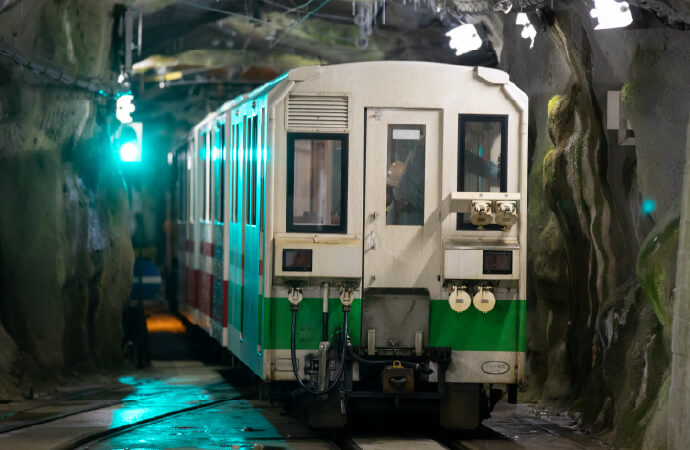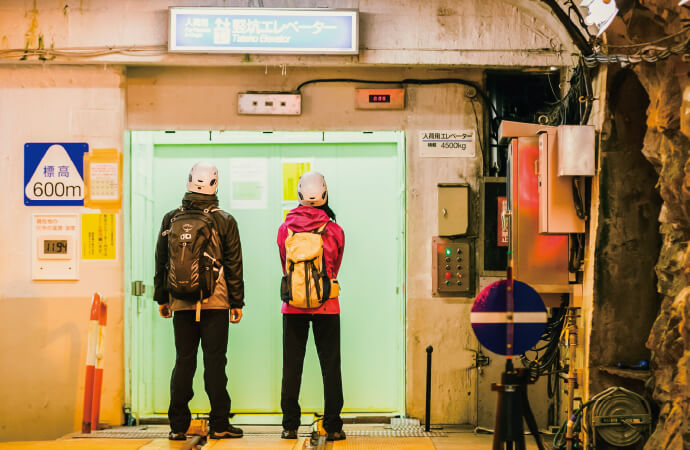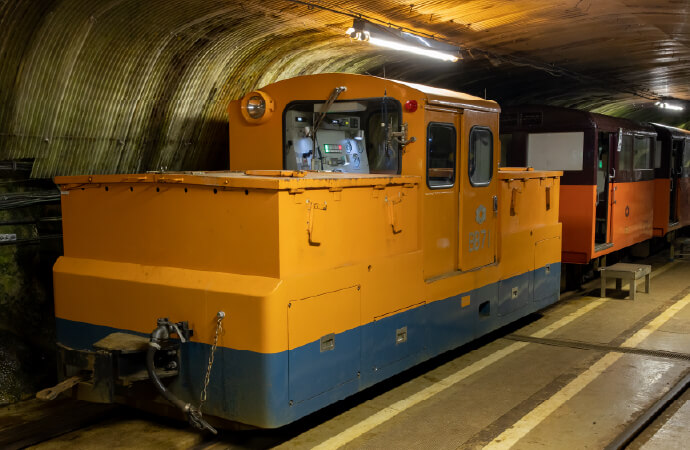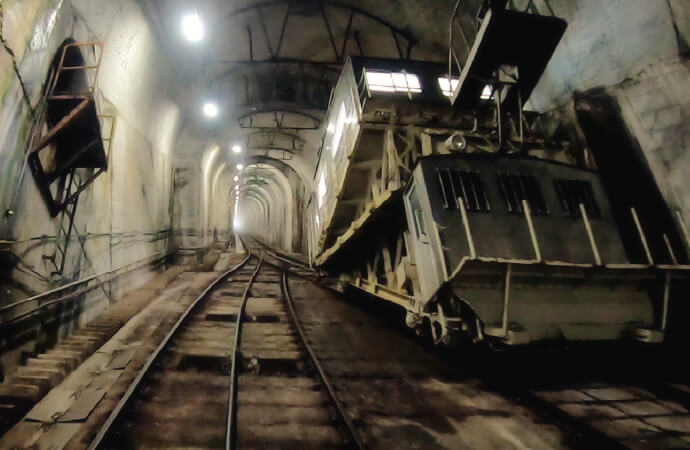This route, which was used to support construction of the Kurobegawa No 3 and No. 4 Power Stations, was built in the early 20th century after a very difficult construction process in the harsh natural world of the Kurobe Gorge. When this new route opens up to the public, it will make use of unique, heavy vehicles that have been used since those pioneering days, and give a unique opportunity to experience the history of power development in Japan.
HistoryHighlights
Highlights
Point01Experience unique methods of transportation
Narrow-gauge construction railway

This Torokko, a narrow-gauge railway connecting Keyakidaira Station, the terminal station on the Kurobe Gorge Railway, and the vertical elevator, has been used to transport workers and construction materials since about 1935. It runs about 500 meters on a three-minute trip through a dark tunnel.
Shaft Elevator

Travels a vertical distance of 200 meters. This huge elevator moving vertically through the mountain was created because the terrain was too steep to extend the railroad. When it was built in 1939, it had the greatest vertical travel of any elevator in Japan.
Battery Locomotive

Operates on a 6.5-kilometer route from Keyakidaira Jobu at the top of the vertical shaft elevator to the Kurobegawa No. 4 Power Station. When the route was excavated, the rock in places reached temperatures as high as 160°C; even today it is some 40°C.
Funicular

Completed in 1959, it was built to transport equipment for the construction of the Kurobegawa No. 4 Power Station, with a length of 815 meters and a steep 34° slope. It takes about 20 minutes to travel in one direction. The job of excavating this long, steep shaft within the mountains was unprecedented.
Point02A panorama of nature

Along this Route running through the inner part of the Kurobe Gorge you can see natural scenes previously only veteran climbers could access. At the elevator shaft observatory, a short distance from Keyakidaira Jobu at the top of the elevator, a panoramic view of the Kurobe mountain backcountry spreads out before you. A view of Mt. Hakubayari, which can’t be seen from Keyakidaira Station, is one of the highlights. At Sennindani, one of the points along the battery train route, is Sennindani Dam (Kurobe No. 3 Dam), built before the war, and the magnificent mountains spreading out behind. From Taruzawa horizontal pit, a tunnel opening off the side of the main tunnel, is a view of Ura ("back") Tsurugi, the far side of Mt. Tsurugi which can't be seen from the lowlands.
Point03A trip into the era of power development
The Route itinerary
Unazuki Station
Start at Unazuki Station on the Kurobe Gorge Railway. There are a variety of restaurants and shops inside the station. Unazuki Onsen, Toyama’s biggest hot spring, is located nearby, making this an ideal base for travels.
01
Narrow-gauge train travel time: 80 minutes
The narrow-gauge train on the Kurobe Gorge Railway line runs through the natural beauty of the gorge from Unazuki Station to Keyakidaira Station. Along the way are truly unique travel destinations, the kind you’d expect in this still unexplored region. Be sure to allow enough time to get off the train and explore.
Keyakidaira Station
From Keyakidaira Station, the terminal of the Kurobe Gorge Railway, the New Route "KUROBE - UNAZUKI CANYON ROUTE" really begins. From here the travel goes inside a tunnel, leaving the sightseeing train for a narrow-gauge work train designed for construction use.
02
Work train travel time: 3 minutes
Traveling on the work train through the tunnel, you come to the shaft elevator. Materials coming from Unazuki Station are carried on the elevator on the freight car of the train.
Keyakidaira Kabu (lower)
This is the lower part of the shaft elevator; here passengers get off the train for the elevator. The floor is wet and slippery, and visitors must watch their step and also be careful of the grooves around the rails as they head to the elevator.
03
Shaft Elevator time: 2 minute
The shaft elevator travels up a vertical distance of 200 meters in about two minutes’ time. Rails are set on the floor of the elevator; the freight cars are brought directly into the elevator.
Keyakidaira Jobu (top)
The elevator arrives at Keyakidaira Jobu, where passengers exit and walk to the elevator observatory.
04
5 minutes on foot
Elevator observatory
The elevator shaft observatory provides a perfect, panoramic view of the 1,543-meter Mt. Okukaneyama. Many other mountains can also be seen, including Mt. Hakubayari, one of the three Shirouma peaks.
05
Battery train: travel time 32 minutes
This train powered by a battery locomotive travels through every stop—Keyakidaira Jobu, Shiaidani, Oriodani, Azohara and Sennindani—on the way to the Kurobegawa No. 4 Power Station. On the way it passes through the High Temperature Tunnel, a fascinating point in the history of construction and power generation development.
High Temperature Tunnel
The train will pass though this tunnel that, when it was first being excavated, had bedrock as hot as 160°C or even higher, causing some accidents, including the spontaneous explosion of dynamite, and making construction exceedingly difficult. Even today the temperature in the tunnel is about 40°C, and those riding the train will both feel the heat and smell sulfur fumes.
!
Sennindani
After passing through the High Temperature Tunnel, the train emerges in Sennindani. From the iron bridge, at an altitude of 859 meters, there are great views of Sennin Dam in the foreground and the 165-meter-tall Kumokiri Waterfall behind.
06
Battery train: travel time 32 minutes
Kurobegawa No.4 Power Plant
At the end of the dedicated train line is the Kurobegawa No. 4 Power Station. Because it is located within a national park, everything has been constructed underground to protect the natural environment above.
07
Funicular: travel time 20 minutes
From the Kurobegawa No. 4 Power Station, the next trip is on the funicular. It is 815 meters long, with a slope angle of 34°; it takes 20 minutes to travel one way.
Bus: travel time 40 minutes
From the top of the funicular, transfer to the Kurobe Tunnel bus, for a trip to Kurobe Dam. There are five horizontal shafts on the 10.2-kilometer-long Kurobe Tunnel; exit the bus at Taruzawa horizontal pit.
Ura Tsurugi
Here is a view of the famous Mt. Tsurugi from the opposite direction from the more common view from the Toyama Plain below, so it is called Ura (“back”) Tsurugi. The view of the majestic, rough ridges is something only climbers and others who have traveled on a long and steep trail to get here have seen. Taruzawa horizontal pit is one of very few spots (certainly in Japan) where the spectacular sight of a glittering glacier awaits.
!
Kurobe Dam
The final destination is Kurobe Dam. From the dam the course goes to Daikanbo and Murodo, then on the Alpine Route down to Tateyama Station.
08
To the Tateyama Kurobe Alpine Route
From Tateyama Station, via the Tateyama Kurobe Alpine Route
Kurobe Dam
The starting point is the entrance of the Kurobe Tunnel, which connects to Kurobe Dam and Kurobegawa No. 4 Power Station. Then take the bus.
01
Bus: travel time 40 minutes
Take the bus to Taruzawa horizontal pit. Enjoy the magnificent scenery before heading for the funicular.
Ura Tsurugi
Here is a view of the famous Mt. Tsurugi from the opposite direction from the more common view from the Toyama Plain below, so it is called Ura (“back”) Tsurugi. The view of the majestic, rough ridges is something only climbers and others who have traveled on a long and steep trail to get here have seen. Taruzawa horizontal pit is one of very few spots (certainly in Japan) where the spectacular sight of a glittering glacier awaits.
!
Funicular: travel time 20 minutes
From the Kurobegawa No. 4 Power Station, take the funicular. It is 815 meters long, with a slope angle of 34°; it takes 20 minutes to travel one way.
Kurobegawa No.4 Power Plant
Arrive at Kurobegawa No. 4 Power Station. Because it is located within a national park, everything is located underground to protect the natural environment above.
02
Battery train: travel time 32 minutes
Take the battery locomotive from Kurobegawa No. 4 Power Station to Keyakidaira Jobu, then on to Shiaidani, Oriodani, Azohara and Sennindani. On the way it passes through the High Temperature Tunnel, a fascinating point in the history of construction and power generation development.
Sennindani
After passing through the High Temperature Tunnel, the train emerges in Sennindani. From the iron bridge, at an altitude of 859 meters, there are great views of Sennin Dam in the foreground and the 165-meter-tall Kumokiri Waterfall behind.
03
High temperature Tunnel
The train will pass though this tunnel that, when it was first being excavated, had bedrock as hot as 160°C or even higher, causing some accidents, including the spontaneous explosion of dynamite, and making construction exceedingly difficult. Even today the temperature in the tunnel is about 40°C, and those riding the train will both feel the heat and smell sulfur fumes.
!
Battery train: travel time 32 minutes
Elevator observatory
The elevator shaft observatory provides a perfect, panoramic view of the 1,543-meter Mt. Okukaneyama. Many other mountains can also be seen, including Mt. Hakubayari, one of the three Shirouma peaks.
04
5 minutes on foot
Keyakidaira Jobu (top)
From the elevator observatory, walk to Keyakidaira Jobu for the elevator.
05
Shaft Elevator time: 2 minute
The shaft elevator travels up a vertical distance of 200 meters in about two minutes’ time. Rails are set on the floor of the elevator; the freight cars are brought directly into the elevator.
Keyakidaira Kabu (lower)
This is the lower part of the shaft elevator; here passengers get off the train for the elevator. The floor is wet and slippery, and visitors must watch their step and also be careful of the grooves around the rails as they head to the elevator.
06
Work train: travel time 3 minutes
The work train travels the last 500 meters of the tunnel section of the New Route.
Keyakidaira Station
The station is the final stop for the work train; transfer here to the sightseeing narrow-gauge train for Unazuki Station.
07
Narrow-gauge train: travel time 80 minutes
The narrow-gauge train on the Kurobe Gorge Railway line runs through the natural beauty of the gorge from Keyakidaira Station to Unazuki Station. Along the way are truly unique travel destinations, the kind you’d expect in this still unexplored region. Be sure to allow enough time to get off the train and explore.
Unazuki Station
Start at Unazuki Station on the Kurobe Gorge Railway. There are a variety of restaurants and shops inside the station. Unazuki Onsen, Toyama’s biggest hot spring, is located nearby, making this an ideal base for travels.
08
